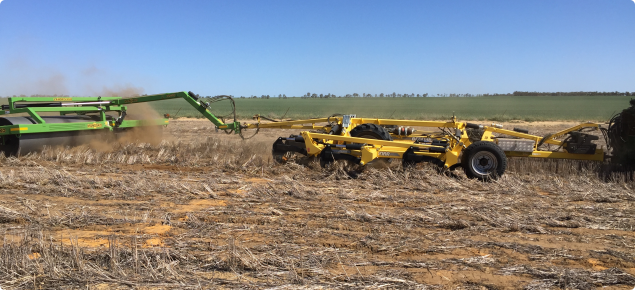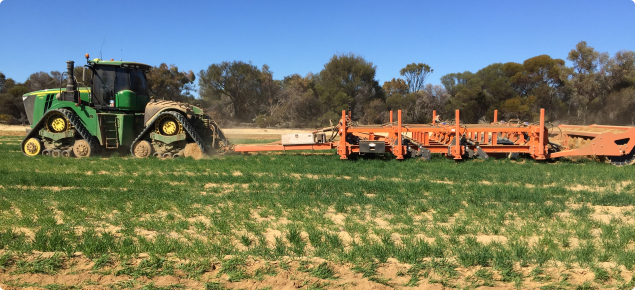This tool can be used to estimate the additional return from deep ripping in relation to fuel price. The additional return is from the increased grain income from deep ripping minus the cost of ripping.
Additional income return deep ripping ($/ha) = (grain yield response t/ha * grain price $/t) - cost of ripping $/ha
In the 'input cost' tab, users can add their own fuel use, costs, potential grain yield responses to deep ripping and grain prices.
Grain yield response will vary depending on soil type and the presence of other soil constraints. Sandplain soils with a machinery induce compaction layer 20-50cm typically have a yield response of 600kg/ha compared to heavy red loams where there is often no response to deep ripping.
If unsure of grain yield responses and deep ripping costs, the following estimates based on DPIRD and GRDC research could be used as a guide:
- Fuel use L/ha: 16.05L/ha 30-40cm ripping depth, 34.4L/ha 60cm ripping depth (Parker et al 2018 unpublished)
- Work rate ha/hr: 5.8ha/hr 30-40cm ripping depth, 2.6ha/hr 60cm ripping depth (Parker et al 2018 unpublished)
- Ripping costs $/ha = fuel costs + time costs (Depreciation $100-120/hr 500hp tractor wages $43/hr including superannuation, repairs $5/ha)
- Average cereal yield response of DPIRD and GRDC funded trials (Table 1)
| | Average cereal yield (t/ha) | |
|---|---|---|
| Ripping depth (cm) | 1st year | 2nd and 3rd years |
| 30-40 | 0.4 | 0.2 |
| >55 | 0.6 | 0.4 |
The tool presents the results for one season after deep ripping and for three seasons to account for longer lasting ripping benefits. The additional return from deep ripping is calculated for one year alone where the cost of ripping is accounted for in the first season. In this scenario, at a high fuel price greater than $2/L, if the grain yield response is minimal, then it may not be economical to deep rip this year. However the benefit of deep ripping commonly persists for at least 3 years, therefore, the cumulative 3-year additional return is also estimated based on the assumption that the year one grain yield response is the maximum yield response, and year 2 and 3 are the minimum yield response. This scenario indicates that even with a high fuel price, there is still an economic benefit to deep rip.
The longevity of the deep ripping response is dependent on soil type and minimising re-compaction from heavy cropping machinery using strategies such as controlled traffic farming. Controlled traffic farming matches the wheel track spacing and operating width of machinery used for cropping operations.
The amount of fuel used for deep ripping will change with depth of ripping and soil moisture. Dry soil conditions increase fuel use and may reduce the depth of ripping as the tractor is not able to get enough power to the ground. This could mean that the subsoil compaction layer that is typically 20 to 50cm deep is not removed completely due to shallow ripping, therefore can be a greater risk of the crop haying off early in a dry spring in low rainfall areas.
Fallow can provide a good opportunity to deep rip in spring when soil moisture is at an optimal level to achieve good ripping depth. Deep ripping in spring also allows the top soil to resettle over summer reducing plant establishment issues and minimises the risk of soil erosion. Its important to maintain good ground cover levels to protect the soil from erosion.
Where possible avoid ripping rocky areas that increased the risk of machinery breakages, especially if using the same tractor for seeding.
It is worthwhile for growers to do their own sums, taking into account the expected soil type response and cost of ripping to the optimum depth.
Reference
Davies S, Macdonald L, Scanlan C, Parker W and McBeath T (2020) West to South: a regional comparison of constraints and yield response to amelioration of sandy soil, Grains Research Updates 2020, Perth.
Acknowledgements
GRDC and DPIRD project DAW1902_003RTX "Re-egnineering soils to improve the access of crop root systems to water and nutrients stored in the subsoil".


